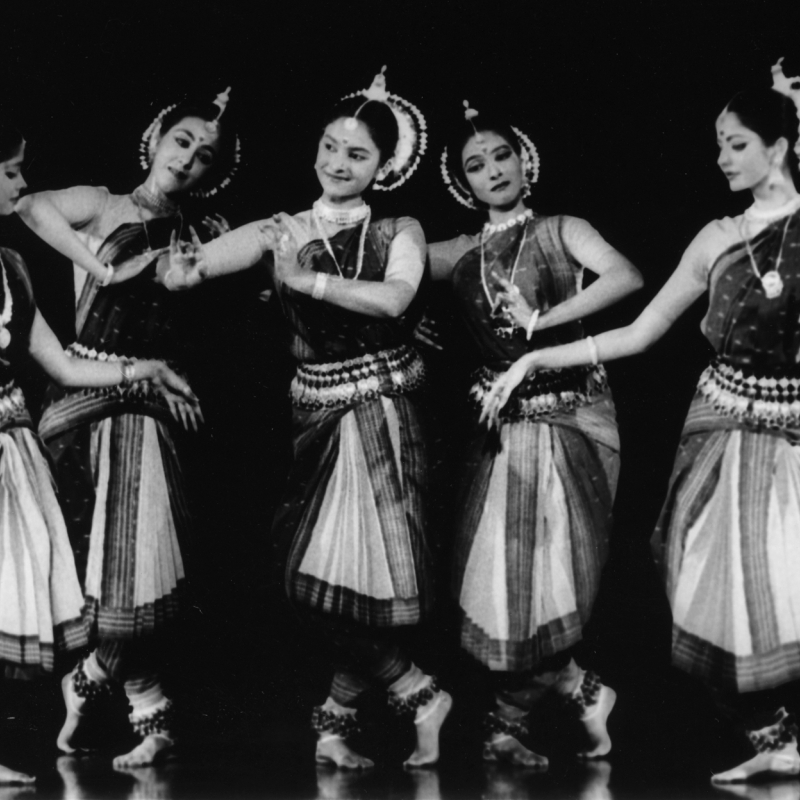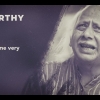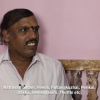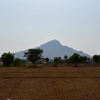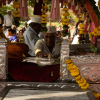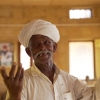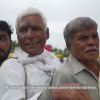My Encounter with Odissi
In 1957, at the Bombay University Library, I came across a small booklet on Odissi dance authored by Kalicharan Patnaik that had a cover photo of Priyamvada Mohanty. The booklet contained a bit of early history of Odissi dance with references to the Odra Magadhi (Odisha and Magadh) regions, along with a few photographs showing the various basic positions of nrittya (pure dance) and some preliminary information about the dance form.
Later, I watched Odissi performances by Indrani Rahman at Regal Cinema in Mumbai—an absolutely new experience because then one did not know that there existed a classical dance form in Odisha.
In 1954, during an inter-university youth festival in Delhi, Priyamvada Mohanty performed a few items of Odissi and received the third prize. That was the first time that Odissi was performed anywhere outside Odisha. Indrani Rahman was present there, and was mesmerised by the dance form. Later on, at the suggestion of art historian and critic Charles Fabri, she went to Bhubaneswar to observe the maharis or devadasis perform. The maharis had, by then, practically given up dancing in temples, but they remembered some movements and songs which were rendered in the sanctum sanctorum of the Puri Jagannath Temple. Indrani also met young Debaprasad Das, and, impressed by his style, learned a few items under him. Thus, she was the first non-Odia dancer to learn Odissi, and later on present it on stages across India and abroad.
In 1958 (March 31–April 7, to be exact), Sangeet Natak Akademi (SNA) organised the historic All India Dance Seminar and Festival as part of a series of national seminars organised in the post-Independence scenario to take stock of Indian drama, music and dance. I was advised by Prof. Mohan Khokar to attend the dance seminar.
My association with Prof. Khokar had begun much before this. At that time, he was editing special issues of Marg quarterly (edited by Dr Mulk Raj Anand) on the classical dance forms of Bharatanatyam, Kathak, Manipuri and Kathakali, with leading exponents and scholars. I read the issue of Marg on Bharatanatyam (September 1957) and got in touch with Dr Mulk Raj Anand, with a request to meet Prof. Khokar. Mohan Khokar was a professor of dance at the newly established MS University at Baroda. Dr Anand gave me a letter asking Prof. Khokar to guide and advise me (I was interested in a scholarly pursuit of classical dance instead of continuing with my career in Chartered Accountancy). I went to Baroda and met Prof. Khokar. That was a turning point in my life as he convinced me to take up the study of dance seriously and write on it. He showed me his collection of books on dance, photographs, magazines, letters and correspondence with writers and dancers and lot of material he had accumulated over the years. He advised me to complete my studies, and then take up research and writing on dance.
So, on Prof. Khokar’s advice, I went to attend the Dance Seminar and Festival in New Delhi where he presented two papers on Theyyam: ‘Ritual dances of South India’ and ‘Shaivism and Vaishnavism in Indian Dance’. A galaxy of scholars, dancers, gurus, writers and critics presented papers and demonstrated dance forms followed by discussions. In the evening, performances by leading dancers and dance dramas were held at Talkatora Gardens. For me that experience was another turning point. I was perhaps the youngest up and coming scholar to attend the seminar with Prof. Khokar. I met great dancers, gurus, writers and critics, and watched a variety of dance and dance dramas.
It was during one morning session that Kavi Chandra Kalicharan Patnaik, a poet, dramatist and scholar from Cuttack, presented a paper on Odissi dance. There was also a demonstration of the technique of Odissi by young Guru Debaprasad Das. Many in the audience were watching Odissi dance for the first time in their lives. Debaprasad Das showed us the basic stances like chauka, abhanga, tribhanga, atibhanga, arasas, units of dance, recited mnemonic syllables, and ukutas. Kalicharan described the order of dance. The concert would begin with bhumi pranam, followed by bighna raj puja, then batu nritya on swara and on badya, ukuta (mnemonic syllables), then ishtadeva vandana, swara pallavi nritta, saabhinaya nritya (song, bhava and abhinaya), tarijham or shula and pahapata nritya. A young dancer named Jayanti Ghosh, from Cuttack, performed some of these items. Thus, this was my first real exposure to Odissi dance.
The paper on Odissi Dance presented by Kalicharan Patnaik at the SNA 1958 seminar in Delhi was edited by me for Sangeet Natak Akademi in two volumes— Sangeet Natak: Volume XLVVII and XLV XIII published by SNA numbers 1-4 2013 and 1-4 2014. Currently the volumes are available at SNA and are important reference books. The photos of Debaprasad Das and Jayanti Ghosh taken by Govind Vidyarthi are also available at the SNA Archive.
Going to the Roots: My Study of the Dance
During the SNA seminar, I met Babulal Doshi, a Gujarati gentleman, the secretary of Kala Vikas Kendra at Cuttack. He had established the institute for training young dancers in Odissi dance. He was a freedom fighter and a socialist, and was close to Smt. Kamala Devi Chattopadhyay, the Vice Chairman of SNA. He had taken a vow that till he got a pucca building for Kala Vikash Kendra, he would not wear chappals. He put in tremendous effort to collect sufficient funds and finally got a building built, where the great guru Kelucharan Mohapatra spent many years teaching Odissi to young girls. Mohapatra was a genius, who along with Guru Pankaj Charan Das and Debaprasad Das gave shape to Odissi, creating proper dance numbers. They drew inspiration from patachitra paintings and innumerable sculptures from the temples in Bhubaneswar and Konark. The entire period of reconstruction of Odissi in the 1950s plays a very important role in the history of the dance form.
Babulal Doshi invited me to visit Cuttack and undertake a research on Odissi for writing a book. My visits to Cuttack, Bhubaneswar, Konark and Puri to study sculptures and paintings and observe how gurus correlated these with practical dance were an eye-opener. Watching Guru Kelucharan Mohapatra training young Kumkum Mohanty (nee Das) and several young dancers, I saw the construction of various items like bhumi pranam, batu nritya, pallavi, abhinaya to Odiya songs, also Gita Govinda ashtapadis, and the final item, moksha.
Babulal wanted to get photographs of dance sculptures, main Odissi exponents, gurus and Gotipua dancers for the Kala Vikash Kendra archives and also for the proposed book I was planning to write on Odissi. I was regularly writing articles for The Illustrated Weekly of India then. Upon Babulal Doshi’s advice, we invited renowned photographer Dhiraj Chavada, whose photographs regularly appeared in the Times Group publications. He had photographed well-known dancers like the Jhaveri sisters, Yamini Krishnamurti, Padma Subramanyam, Sonal Mansingh (nee Pakvasa) and others.
When Dhiraj Chavada came to Bhubaneswar, we contacted Guru Pankaj Charan Das in Puri as we wanted to observe the festival of Chandan Jatra. During this festival, the proxy idols of Lord Jagannath, Balabhadra and Subhadra are taken for a boat ride, and to entertain the Lord, a Gotipua dancer performs on the boat to the accompaniment of music. That year, Guru Pankaj Charan Das was to accompany a Gotipua dancer on the pakhavaj.
Dhiraj photographed the entire process of the young performer dressing up in the female costume as per the Gotipua tradition. Later, we got on another boat to follow the performers’ boat that was to take rounds of Lake Chandan Pokhri. Traditionally, there were two types of boats, one with a white canopy and the other with a red canopy. The red canopy boat was for Mahari performers, but by then they had stopped performing in the boat. But the white canopy boat was used for the Gotipua performance, and Dhiraj could photograph the Gotipua dancer performing. These were rare photographs, as so far no one had taken the photographs of the Gotipua performance on the festival boat.
During this period, scholar-poet Jiwan Pani was working as an administrative officer in the Education Department in Puri. Upon my request, he collated songs which were sung during Chandan Jatra. These Odia songs were published along with my article on Gotipua boys and Chandan Jatra in Sangeet Natak, a quarterly journal of Sangeet Natak Akademi. I wrote another article which was published as a cover story of The Illustrated Weekly with the image of young Gotipua dancer Rabinarayan performing in the akhada (a place with facilities to lodge and train). This was also for the first time that any article on Gotipua dancers was published in a major English publication.
After completing my CA, I joined the commerce department at Sydneham College in Mumbai to teach accountancy, but I continued with my research work on Odissi during my holiday visits to Cuttack. I read journals of Kala Vikash Kendra which contained articles by Odia scholars. There were records available of Madla Panji, chronicles of worship conducted at the main temple of Lord Jagannath in Puri. Scholar Sadashiva Rath Sharma, who was a priest at the temple and had seen Maharis performing in the inner sanctum sanctorum, had edited a book on Abhinaya Chandrika the seventeenth-century palm leaf manuscript by Maheswar Mahapatra, which also mentions the bandha nritya (acrobatic dance) performed by Gotipua dancers. Bandha nritya is very acrobatic in nature and demands a great degree of elasticity of limbs, and, for this reason, Gotipua boys generally ceased to perform after they attained puberty. Later, they became gurus and performed abhinaya to Odiya songs. Accompanied by my poet and painter friend Gulam Mohammed Sheikh, we went and photographed the bandha nritya performance of Guru Debaprasad Das’s disciple Bijoy Lakshmi Mohanty. We were able to record several bandhas that she executed.
We were told that Guru Kelucharan Mohapatra used to be a Gotipua. Many years later when Kumkum Mohanty established Odissi Research Centre, where Mohapatra was the principle teacher, we recorded Gotipua dancers during Chandan Jatra and Jhulan Jatra, the two major festivals when they performed outside temples. We also recorded their performances in mathas (monasteries), in front of the Lord seated on a swing. These rare recordings are in the archive of Odissi Research Centre, now named as Guru Kelucharan Mohapatra Odissi Research Centre. It also has several rare video recordings of dance and music seminars held there, and music recordings of Kishorechandranana Champu and other traditional songs to which Odissi dance is performed. Thanks to Kumkum Mohanty’s initiative, recordings of dances by the three chief architects of Odissi—Guru Pankaj Charan Das, Guru Debaprasad Das and Guru Kelucharan Mohapatra—are preserved in Odissi Research Centre. Kumkum Mohanty also managed to get recordings done of Sakhi Nach, the dance form from Ganjam district. Mohanty authored The Odissi Dance Path Finder, a manual for basic positions and movements, with illustrations and nomenclature for hasta mudras and body positions. Her efforts in putting together the manual, under the guidance of Guru Mohapatra and others, brought an order to the existing Odissi dance tradition in its years of development.
During one vacation, we went to Kumbhari village with Guru Debaprasad Das to document the sabdaswarapata tradition (a ritualistic dance form) prevalent in Sambalpur area. Tradition has it that a sadhu brought a palm-leaf manuscript from Puri to the temple of Vajreshwari in the village Kumbhari in Sambalpur district, which was placed in the temple and is still worshiped. Legend has it that the Goddess Vajreshwari had adopted Lord Krishna, and as a symbol a peacock feather representing Krishna is placed in the temple and worshipped.
The sabda aspect refers to Sanskrit shloka pertaining to the deity concerned, like Shiva, Durga, Ganesha, etc. Guru Debaprasad Das used sabdaswarapata in his compositions in praise of gods and goddesses; his disciple Gajendra Panda also uses them in his performances.
My research work was completed by 1988, and by 1990 Marg Publication brought out my book, Odissi Indian Classical Dance Art, with photographs by Avinash Pasricha. This book is now out of print.
Today the Odissi dance has won important position along with most popular forms like Bharatanatyam and Kathak. There are also a number of male dancers who have taken to Odissi successfully and are creating their own niche. Group dances and dance-dramas have also become popular vis- à-vis solo dance. Odissi music has also contributed to popularity of Odissi dance. Abroad, Odissi is regularly presented in international festivals. Within a period of some 70 years, Odissi has achieved a glorious position as an important classical dance form.
(Banner image courtesy: Madhavi Mudgal)
